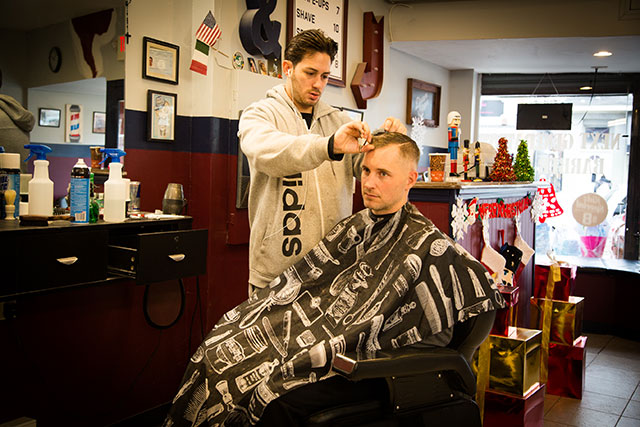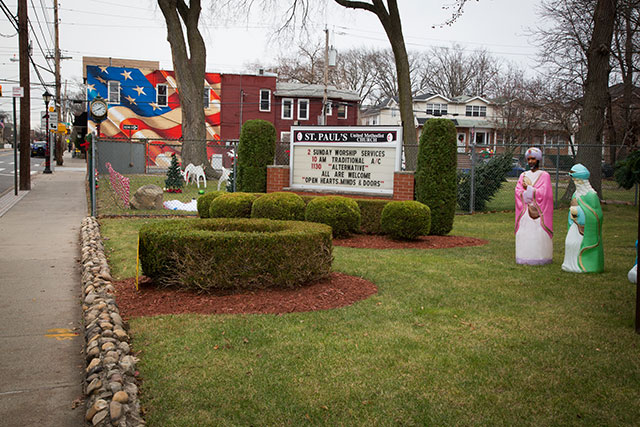In Lower New York Bay, five miles south of Manhattan, sits a chunk of America known as Staten Island, the “forgotten borough” of New York City. Properly named Richmond County, “Staten Island” has become New Yorker shorthand for an out-of-the-way, irrelevant place: the obscure, un-hip home of the world’s largest garbage dump, which is to be turned into a park. A half-hour ferry ride remains the quickest route to New York City’s business district from the borough, which has no subways. Alternatively, one can drive to Manhattan over a series of bridges and tunnels, via the Gowanus Expressway, one of the nation’s most reviled and decrepit stretches of highway.
For residents, though, the stereotypes are as false as they are uncharitable. To them, Staten Island offers pleasant neighborhoods, with plenty of parks and beaches. Civic organizations enhance a rich community life, replete with parades, church pancake breakfasts, and cross-generational local activities. Schools are good; streets are safe. Many complain about overdevelopment, but Staten Island is much less thickly settled than the rest of Gotham, offering middle-class families a chance to buy homes with lawns and driveways. Though Staten Islanders pay a higher effective property-tax rate than many other New Yorkers, their taxes remain lower than those in comparable areas of Nassau County or New Jersey.
Staten Island has long represented conservative values traditionally associated with suburban rather than urban polities, and it has served as a political and cultural counterweight to the far-left excesses of New York’s other boroughs, especially Manhattan and the Bronx. With the completion of the Verrazano-Narrows Bridge in 1964, Staten Island was joined to Bay Ridge, Brooklyn, and a veritable land rush followed, with a largely white-ethnic exodus into the previously remote borough. Staten Island has largely retained its political complexion since then, the quintessential “outer borough,” even as Brooklyn and Queens have undergone radical transformations.
Statistically, Staten Island is an anomaly in New York City. More than half of the adult population is married, compared with less than 40 percent throughout the city as a whole. Fewer than 15 percent of Staten Island households are “nonfamily,” whereas upward of 40 percent of households citywide are so characterized. The citywide rate of unmarried births is almost double the rate on Staten Island.
Staten Island’s demographics distinguish it from the other boroughs in further ways. New York City as a whole is 32.5 percent white non-Hispanic, but whites—still mostly of Irish and Italian descent—constitute 62.8 percent of Staten Island’s population. Ten percent of all NYPD officers live on Staten Island—a remarkably high number, considering that only 58 percent of NYPD cops live in the city. On Staten Island, owners account for 70.5 percent of occupied housing units, versus only 32 percent in New York as a whole.
The borough’s north shore, which includes the ferry terminal, resembles the rest of New York City, with concentrations of black, Latino, and Asian New Yorkers. Staten Island becomes most distinctive in its southern two-thirds, below the Staten Island Expressway, which local wags sometimes call the “Mason-Dixon Line.” The fabled south shore, where even today more than 75 percent of residents report Italian ancestry, remains the region that defines Staten Island in popular imagination.
The 2016 presidential election typified Staten Island’s political identity—the borough bucked the rest of New York’s blue tide and turned out substantially for Donald Trump. “New York City’s red state finally got its revenge,” Gersh Kuntzman wrote in the Daily News, casting the borough as insular and ignorant—a common media habit. “This island is not only surrounded by water, but it appears at times to be completely cut off from facts, too.”
The rest of New York City voted overwhelmingly for Hillary Clinton in the 2016 race. Citywide, she won 79 percent of the vote. In Manhattan, where she took 87 percent of the ballots, she won every electoral district except a tiny sliver of midtown, where only 14 people voted. Trump won less than 10 percent of the vote in the Bronx, and he did miserably in his home borough of Queens, too, where Clinton bested him by more than 50 percentage points. But on Staten Island, Trump took 57 percent of the vote. In the 62nd assembly district—on the borough’s south shore—Trump won almost 75 percent of the more than 50,000 votes cast, making it the most pro-Trump district in all of New York State. In fact, virtually no lower-house legislative district in the Northeast went so strongly for Trump. Even in Ohio—where Trump won by eight points—only one legislative district put up stronger numbers for Trump than the south shore: the 84th House district, the state’s largest agricultural producer, voted 80.6 percent for Trump. In rural Pennsylvania, a handful of state assembly districts gave Trump comparable numbers—the 66th assembly district, for instance, which borders the Allegheny National Forest and where the largest city is Punxsutawney, population less than 6,000. By contrast, Staten Island’s south shore is part of the nation’s largest metropolis, has a median household income over $90,000, and boasts higher education levels than New York State as a whole. Staten Island is a rock-ribbed Republican redoubt in a sea of blue.

The borough’s conservatism has often played a crucial role in the city’s political fate. In 1993, Mayor David Dinkins ran for a second term against Rudy Giuliani, whom he had narrowly defeated in 1989. New York City was facing serious challenges. Crime peaked during Dinkins’s first term, and the city was seeing close to 2,000 murders annually, with incidents of rape on the rise. The national recession of 1990–91 was still hobbling New York’s economy, and unemployment had soared from 6.7 percent in 1989 to 11.1 percent in 1992. The 1991 Crown Heights riots—when mobs of blacks attacked residents of a Jewish neighborhood for three days following a car accident that killed a black child—left many New Yorkers with the impression that Dinkins had let the mayhem continue out of racial solidarity with the rioters.
During this period, a secession movement caught on among Staten Islanders, aggrieved about the 1990 doubling of the round-trip fare for the Staten Island Ferry to 50 cents and about the city’s refusal to close the Fresh Kills dump—the first landfill in the United States, which would become the largest man-made structure on earth. In the infamous “Syringe Tide” of 1987 and 1988, medical waste from Fresh Kills made its way onto local beaches; the ensuing publicity made Staten Island the butt of jokes. Perhaps frustrated by Dinkins’s perceived mismanagement of city finances, then-governor Mario Cuomo let a nonbinding secession referendum appear on the 1993 ballot—the same ballot on which Dinkins and Giuliani would contest the mayoralty for the second time.
The secession measure passed by a 2–1 margin and helped drive turnout on Staten Island to record highs—providing the margin of Giuliani’s victory. Giuliani won 82.8 percent of the vote in Richmond County, with 20,000 more people turning out to vote than in 1989. “Rudy is the mayor of Staten Island,” said Dinkins media strategist and Democratic campaign consultant Bob Shrum, following his candidate’s defeat. Giuliani didn’t forget his Staten Island base. He eliminated the fare for the Staten Island Ferry in 1997, after introducing a one-fare system citywide, and closed Fresh Kills by early 2001. With a Staten Island–friendly mayor in city hall, the island’s drive for independence fizzled out.
In 2001, Giuliani was term-limited out of office, and then–public advocate Mark Green, a Democrat, was heavily favored to win against billionaire and political novice Michael Bloomberg, running as a Republican. The September 11 attacks on the World Trade Center occurred on the morning of the scheduled primary election, which was then postponed for two weeks. Giuliani, whose popularity had fallen off significantly in his last year as mayor, suddenly emerged as a national figure for his leadership following the attacks, which killed more than 2,000 people in lower Manhattan. Staten Island alone lost 275 residents, including many police officers and firefighters, proportionately more than any other borough.
Bloomberg would likely never have won the mayor’s office had the 9/11 attacks not happened. The city, which had lost its appetite for Giuliani’s sharp-elbowed law-and-order style, suddenly questioned the appeal of an old-school liberal like Mark Green, whose signature accomplishment had been to sue the NYPD over purported racial profiling of street criminals. Giuliani’s endorsement of Bloomberg assured traumatized New Yorkers that the business magnate would continue the mayor’s public-safety policies. The election wound up being the closest in city history, and again, Staten Island provided the margin of victory: Bloomberg won by only 35,000 votes citywide, but he took 78.2 percent of Staten Island’s vote, beating Green by more than 61,000 votes.

Staten Island remains a red bastion, but its electoral influence may be on the wane. The 2017 mayoral election demonstrated that Mayor Bill de Blasio will keep moving leftward in his second term. “Everything you can imagine is real!” exulted de Blasio the night he won the Democratic nomination for reelection, quoting Pablo Picasso as he sketched out his vision for a New York that would fulfill the “socialistic impulse,” which, according to the mayor, drives and inspires its people. “We’ve got more to do,” de Blasio told his supporters. “I’ve seen up close the challenges, too. I’ve seen the ways we still need to build a fairer city, and I’m not going to stop until we build that fairer city for every New Yorker.”
De Blasio bested his Republican rival, New York State Assembly member Nicole Malliotakis (of Staten Island), by almost 40 percentage points. On Staten Island, the results were reversed: Malliotakis took almost 70 percent of the vote, compared with de Blasio’s 24 percent. Even if every eligible voter on Staten Island had turned out and voted for Malliotakis, though, de Blasio still would have won.
Demographic changes across the city have made it harder for a traditional moderate or conservative politician to win citywide office—even on Staten Island. As recently as 1980, the borough was 85.3 percent white non-Hispanic; that number has dropped to 62.8 percent today. The percentage of Staten Island residents identifying as Italian in 2009 was 35.4 percent; six years later, the rate had dropped to 31.3 percent. Meantime, the borough’s Hispanic and Asian populations have grown rapidly, and unexpected immigrant enclaves have formed. Staten Island is now home to a significant Liberian community, and it is one of the best places to go for Sri Lankan food.
South Shore aside, what’s unique about Staten Island is not that it is resolutely Republican at election time but that it has political variety and competitive general elections, unlike the rest of New York City. The island has three seats on the city council, two held by Republicans. Two state senators represent Staten Island, one from each party; and four state assembly members serve in Albany, two from each party. The borough president is a Republican, but the county district attorney is a Democrat. The current congressman is a Republican, but the seat has been held previously by a Democrat and is considered competitive—at least by the standards of New York, where incumbents win by 50- or 70-point margins, if they even face a challenger.
Ultimately, then, it’s not that Staten Island is an outlier but that New York City is one. Staten Island, with its diversity of political opinion, resembles the rest of the United States. Not so the rest of New York, which has steered itself on a hard course left.
Research for this article was supported by the Brunie Fund for New York Journalism.
Top Photo: The 1964 completion of the Verrazano-Narrows Bridge, which linked Brooklyn to Staten Island, sparked a land rush into New York’s least populous borough. (THE MUSEUM OF THE CITY OF NEW YORK/ART RESOURCE, NY)






